Following years of growth in the North European lit tomato cultivation, the European tomato sector has changed drastically in recent years due to the energy crisis and the rugose virus. The refusal of buyers to provide price guarantees made profitable cultivation of tomatoes under illumination impossible. Now that energy rates have stabilized, resistant varieties are making headway, and LED lighting has been embraced, lit tomato cultivation is on the rise again.
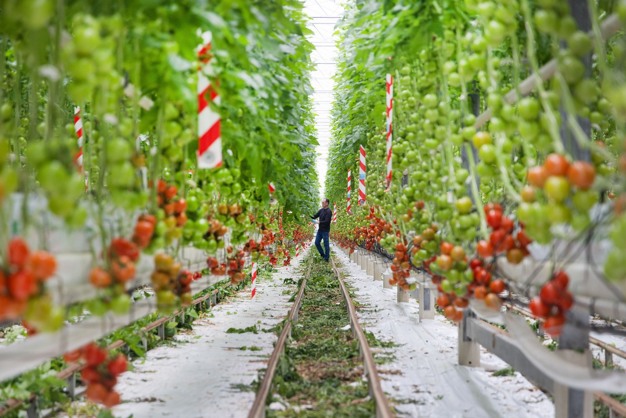
It has been three years since energy prices in Europe rose to the point where cultivation under illumination was no longer profitable. Growers faced particularly difficult choices at the start of the illuminated season in the autumn of 2021. "Some crops were discarded, while others chose to continue cultivation with reduced energy and lighting. Then there was the need to reduce plant load. By adjusting stem density and pruning policies, they attempted to keep the plants upright," recalls Erwin de Kok, Tomato Sales Specialist at BASF | Nunhems, closely involved in the innovative solutions growers had to devise to face the crisis. "In collaboration with the plant nursery, a grower decided to top young Provine plants an extra time, thus delaying the planting date. Eventually, they planted in mid-November, opting for unlit cultivation." Together with the cultivation company, and with the aid of Delphy's QMS planning tool, a cultivation technical plan was devised based on the plant's light requirements, stem density, and other factors. "In the end, it worked out well, but they were emergency measures."
The winter that followed, the 2022-2023 season, also saw very little illuminated supply. Only contract cultivation was still carried out. "Generally, it was focused on the finer types, nothing larger than cocktail tomatoes." The current winter season differs: now, even the coarser types are making a comeback. "Not all illuminated areas are in production yet, but most of them are back."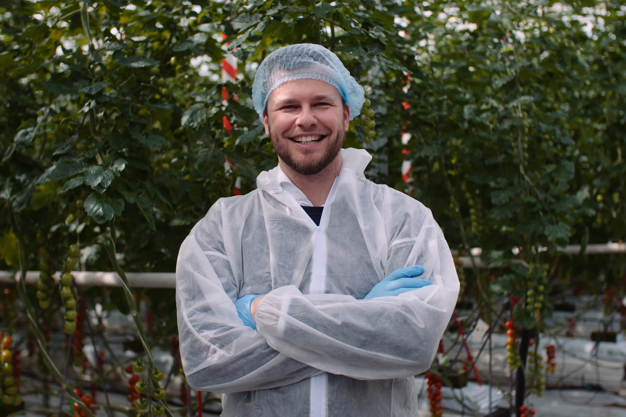 Erwin de Kok, Tomato Sales Specialist at BASF | Nunhems
Erwin de Kok, Tomato Sales Specialist at BASF | Nunhems
Resistances
The resurgence of illuminated production can be attributed to lower energy prices and the availability of resistant varieties. "Illuminated crops are too expensive to risk virus infection," Erwin explains. "Plants are under heavy stress during the winter season, increasing the risk of virus impact. Having a resistant variety is truly essential."
He estimates that 90% of the illuminated area is planted with resistant varieties, significantly reducing the incidence of virus outbreaks compared to before. Exceptions occur with some retailer programs that specifically request a particular variety or type of tomato. "It's crucial for the grower and retailer to negotiate a solid contract regarding this."
Use of data
The characteristics of the resistant varieties are indeed a hot topic of discussion. According to Erwin, this season the fruits seem to be thriving. "In terms of quality, our varieties haven't lost anything, but like with any new variety, there's a learning curve in growing them. You don't reach peak performance in the first season. Throughout the season, we're already thinking ahead: how can we further optimize and fine-tune? We also discuss this with the growers."
The company also utilizes the aforementioned tool from Delphy before commercial cultivation. Based on data from their own trials, such as flowering and setting speed, light efficiency, and ripening time, a crop profile is established early in the breeding process. "This gives us insight into the plant's light requirements, enabling us to develop a solid starting strategy. Growers aim for optimal performance throughout the winter, but that can sometimes place excessive demands on the plant. Especially during the critical period around Christmas, when light is scarce, it's better to adjust pruning policies and decide on the number of stems to maintain during the winter."
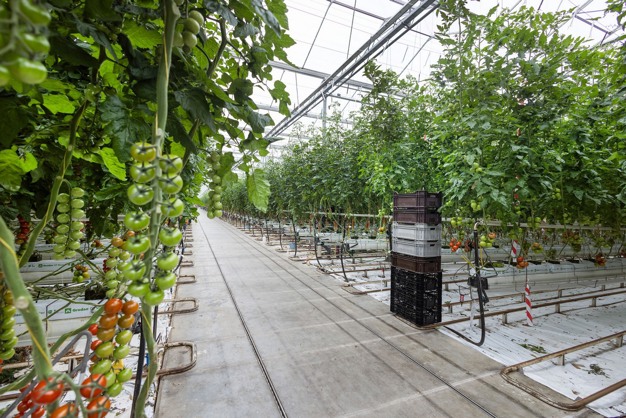
Lighting
BASF also conducts screenings of varieties under illumination to gain insight into how different varieties behave under lamps. In the trial garden in Viersprong, LED and SON-T lamps are installed, with the main focus on LED. "On sunny days with strong winds, the hybrid installation is sometimes activated due to favorable energy prices, but we observe that LED is the direction the sector is moving towards. That's where we aim to make our selections. Ideally, we want all-rounders: our varieties must perform well under both conditions."
The transition to LED lighting is indeed progressing across Europe, notes Erwin. "Hybrid lighting is technically convenient because heat can still be utilized. However, ultimately, the entire sector is transitioning to LED. In the Nordics, this trend has been ongoing for some time, and the level of micromoles under which cultivation occurs is much higher. It's naturally darker there in the winter, which is why they are truly leading the way." Even in lower-lying countries like the United Kingdom and Germany, an increasing number of growers are investing in LED. "But even in Italy, Switzerland, and France, we see various projects with LED. And even in Spain, trials are underway. Although on a smaller scale, just to explore the possibilities of increasing production, it signifies something. We observe a firm transition to LED lighting." This transition is also supported by European subsidies available in various countries for this type of lighting. "Looking ahead, many growers also view it as a sound investment. Ultimately, this is the direction in which the entire sector is moving, and especially in the Netherlands, we anticipate that the majority of the area will have made the switch."
Dynamic lighting is still in its infancy, but dimmable lighting is becoming more commonplace. Based on the irradiation in the greenhouse and set parameters, the lighting is fine-tuned. "This is a positive development for both the plant and energy consumption."
The advancements in LED lighting are rapid, and the techniques are still relatively new. Similarly, working with two or even three energy screens, a practice widely adopted in illuminated cultivation, is becoming more prevalent. Additionally, more horticultural companies are implementing air treatment units. "And they are still closely monitoring gas consumption," adds Erwin. "This means that besides new genetics, growers have to learn to manage four additional factors. Just like in the early years of HPS lighting, we anticipate further optimization in the coming years."
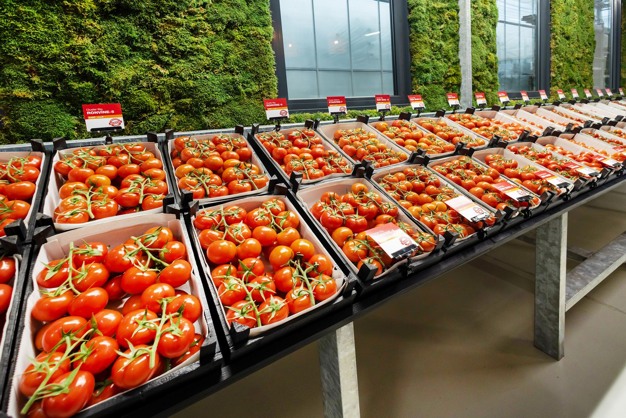 The various varieties in the BASF | Nunhems trial garden
The various varieties in the BASF | Nunhems trial garden
Market demand
No matter how much cultivation can be optimized, in the end, it remains to be seen whether buyers are willing to pay for products from illuminated cultivation. Despite lower transportation costs, it remains a more expensive product. "We came from a situation where many crops from Southern Europe were moving north. There, more and more tomatoes were being grown in high-tech greenhouses, under SON-T lamps. The sector was solidly in the saddle, but the energy crisis made retail and customers move south over the past years. Now that energy prices have stabilized, we see retailers returning to the reliable, quality supply from high-tech cultivation," continues Erwin.
"Cultivation in the south is improving, but reliability cannot be guaranteed, partly due to weather dependency. Now you see that retailers are weighing different options. A large part is returning to high-tech cultivation. The possibilities of countries like Turkey are also being explored, where a lot of high-tech cultivation is possible that can endure the summer well. But then you're dealing with six or seven days of transport. That fits less with food miles and sustainability than producers who can have products in the store a day after harvest. And so, many opt for the supply from high-tech greenhouses."
The only exception to this is snack tomatoes, whose illuminated cultivation seems to have definitively left North-West Europe. "It's too expensive, both in terms of labor and energy. The competition from southern countries is too strong; there, labor is cheaper, and natural energy is used. It's hard to compete against that." For summer crops, it's different: then it's too hot in many southern cultivation regions for tomato cultivation, so there will still be a reasonable area of snack tomatoes remaining in more northerly regions.
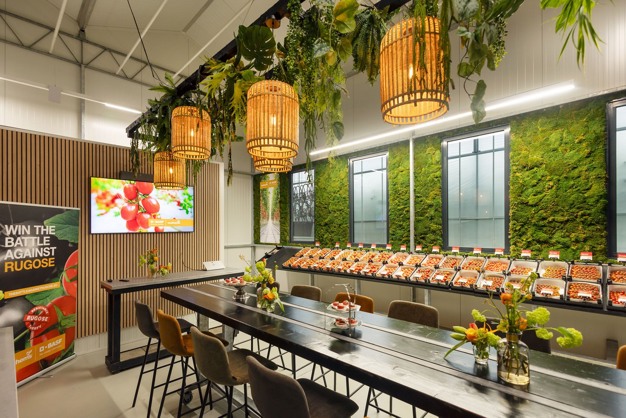
All in all, the tomato sector has undergone significant upheaval in recent years. For breeders, too, the market has changed – and to the advantage of BASF. "The past few years have completely reshaped the entire market, and we see that our resistant varieties are performing well," confirms Erwin. This success is attributed to a combination of genetics and relationships. "In certain segments, we already had strong varieties, but retailers still preferred the certainty of a particular variety that they had been sourcing for many years. During this time, we invested in building relationships throughout the supply chain and gained a reputation as a reliable company that doesn't make exaggerated promises but remains realistic. This has allowed us to gain further ground in recent periods." As an example, he points to the cluster cherries, where they couldn't establish a presence with Adorion (non-resistant), but now with Vitalion, which is ToBRFV resistant and offers premium taste, they are emerging as one of the market leaders. "Moreover, we have seen strong growth in other segments: with RonVine, we have introduced a strong player in medium-coarse and coarse varieties, and we are expanding in cluster cherry with Culturion, a traditional cherry in a slightly larger size. In the Netherlands, we have partnered with a skilled grower who commercially cultivates the variety, and it is also performing well commercially in Switzerland. In the Cocktails segment, we offer an excellently tasting tomato and have also gained a significant market share in the DACH region with it."
Further growth is anticipated. Although snack tomatoes were never the biggest focus for BASF, the resistant varieties have shown considerable potential. Currently, these varieties are undergoing testing at the BASF | Nunhems Tomato Experience Center in Westland. More seeds will become available at the end of July, and later this year, the company will initiate further trials. "For this, we are seeking collaboration with growers and cooperatives that also cultivate further south, or we are exploring the possibility of intermediate planting. With the resistant varieties, we hope to become an important player in the snack segment, similar to what we have achieved with Vitalion in the cherry segment. This appears promising in terms of plant model, and in terms of labor, the varieties seem to be well-suited, with resistance serving as a significant driving force."
For more information: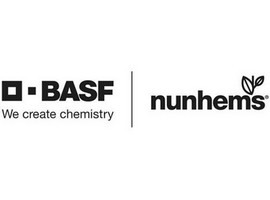
Erwin de Kok
BASF Vegetable Seeds
[email protected]
www.nunhems.nl
